What To Do If Your RV Fridge Won’t Get Cold
We have struggled with keeping our RV refrigerator cold since the day we bought our travel trailer 2 years ago.
It was working fine in the beginning when we had it mostly running on electrical but once we started camping and traveling full time the RV fridge has refused to get down to safe fridge and freezer temperatures when switched to gas.
Related RV Product: This Camco Refrigerator/Freezer Thermometer (click to view on Amazon) will help you monitor your RV fridge and freezer temperatures so you’ll know when there’s a problem.
Taking the fridge to a repairman wasn’t an option for us. I spent hours researching what could possibly be wrong with it online.
I did everything the forums and blogs told me to do to try and fix the problem but it persisted.
Finally, we felt like we had no other option but to change the cooling unit as all the signs pointed toward there being a blockage in the tubing which was stopping the ammonia from heating properly and therefore not cooling the fridge enough.
We took the dive and purchased an Amish built RV fridge cooling unit that was sure to not only keep our RV fridge cold but also be more efficient and effective in hot summer temperatures.
We installed the unit and waited for the fridge to cool. Sadly, it still wasn’t quite right.
I went back to the books, and finally found the answer I had been looking for the entire time. It was the burner orifice.
I had looked at the flame many times to make sure it was blue (it was) and even taken apart the burner to see if it was dirty but I’d somehow missed what I was actually supposed to do.
Once I took apart the burner and cleaned the orifice the right way the flame became strong and the fridge cooled down right away.
My suggestion to RVers who are experiencing problems with their RV fridge not cooling properly is to always do this first.
See Also: Best 12 Volt Refrigerator Freezer For Camping & Travel
In my experience, it’s been the problem every single time and since cleaning the RV fridge orifice the first time I’ve had to clean it again recently to keep the flame strong enough to cool the RV fridge.
It’s worked like a charm both times and it’s so easy to do you may as well give it a shot before taking it to get fixed or replaced.
How Should The Flame In An RV Fridge Look And Sound?
Everything I’d heard and was reading said the flame should be blue with hardly any yellow on top.
After reading that I quickly checked out the flame at the back of the RV fridge and found it to be a healthy blue, just like all the information I was reading said it should look.
Now, I know better.
It’s not really about how the flame looks at all. Yes, it should be blue with very little to no yellow around it but even if it is a nice blue color that doesn’t necessarily mean it’s right.
The sound is what really matters.
See Also: 7 Signs That Your RV Propane Regulator Has Gone Bad
After finally finding the information I needed to properly clean the RV fridge burner orifice and relighting the fridge I instantly heard the difference.
Before I couldn’t hear the flame at all, now I can easily hear the flame when standing by the RV fridge’s outdoor cover and when it’s quiet I can even hear it inside the RV.
This is what you want. A loud happy flame heating the ammonia in the RV fridge coils to keep everything nice and cold.
What Is A Gas Orifice And Where Is It Located On An RV Fridge?
A gas orifice is what’s responsible for releasing the proper amount of gas, in this case, propane.
The orifice has a tiny rectangular hole the propane passes through and into the burner tube to create the perfect size and strength of the flame.
It’s pretty common for something to get in the way of that perfectly cut hole which restricts the gas flow and reduces the flame’s strength which in turn can cause your RV fridge to cool slightly but not enough to stay within the safe temperature zones. (40°F for the fridge and around 0° for the freezer)
The orifice is located behind the outdoor access panel on your RV.
The access panel allows you to see the bottom of the RV fridge’s cooling unit as well as the propane burner set up.
See Also: Best Portable Quiet Inverter Generators For RV Camping
The easiest way to find the orifice is to find the flame. The flame is usually on the right-hand side under the flume which is the large cylinder that goes up behind the fridge.
The flame is normally covered by a metal wind guard but if you peek through the holes on the side you can usually see it.
The orifice is the part directly behind the tube the flame is coming out. Sometimes it’s even one piece.
I’ll explain more about where to find it, what it looks like, and how to remove it in the how to clean the RV fridge gas orifice section below.
How To Clean The RV Fridge Orifice
My RV fridge is a Norcold, the Dometic RV fridges can look a little different on the inside but for the most part, the burner and the orifice have the same general setup and look.
1. Turn Off The Propane & The RV Fridge
You want to turn off the propane by closing the valves on the tanks and turn off the fridge so it doesn’t keep trying to light the flame.
2. Remove The RV Fridge Access Door
Remove the access panel located outside of the RV behind the fridge. It usually has a door like the one pictured below.
Some RV fridges will have two of these doors, one that is on the lower part of the RV and one near the roof.
You want to remove the lower door as this is the one that leads to all the propane parts including the burner and orifice.
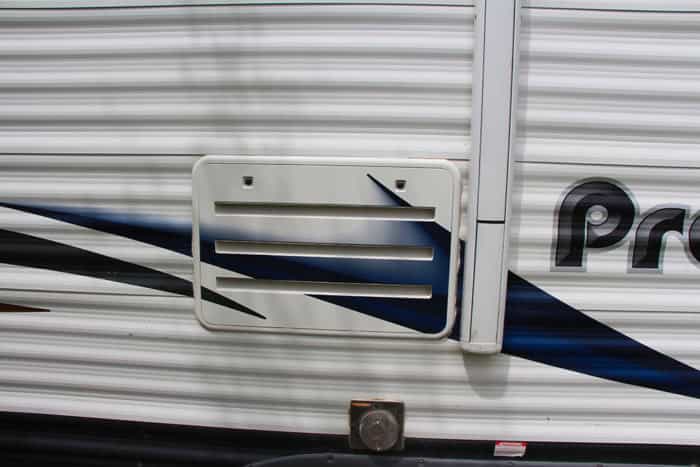
To remove the RV fridge access door all you have to do is use a flathead screwdriver, pliers, or even your fingers to turn the little black knobs on the top.
Turn them halfway so they are both pointed straight up. Pull out and lift the panel off and away from the RV or travel trailer.
See Also: BougeRV CR45 Portable Fridge Freezer Reviewed For Camping/RV
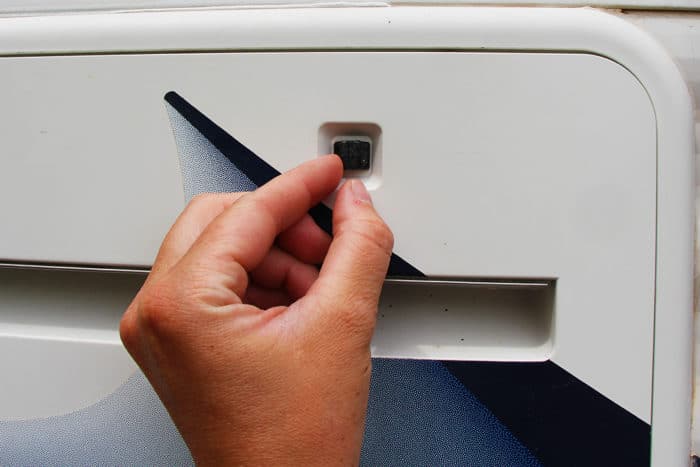
3. Remove The Drip Tray & Wind Cover
Once the outside RV fridge access door is removed you should be able to see the cooling unit, the propane lines, and the burner below it.
This is the back of my Norcold RV fridge with an Amish built cooling unit, the Dometic version will look slightly different but the location of the fridge orifice burner is basically the same.
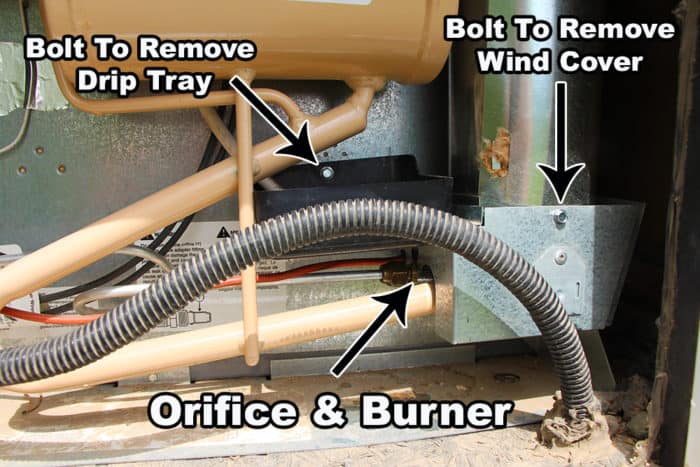
To get to the gas orifice and burner you will need to remove the drip tray and the wind cover.
These are normally secured by a single bolt you can remove with pliers or a drill with the proper size of head on it. (I use pliers since they normally aren’t very tight)
See Also: Best Portable Power Station/Solar Generator For Camping
When you remove the bolt to the wind cover you will be able to move it back but you may not be able to remove it completely.
Just make sure you push it far enough back it’s out of the way.
4. Undo The Propane Gas Line Connected To The Orifice
Once you get the wind cover out of the way you should be able to see the orifice and burner tube clearly. If the flame was burning recently it may be hot so be careful when working with it.
Loosen the nut connecting the propane line and the orifice. It should be lefty loosey just like normal.
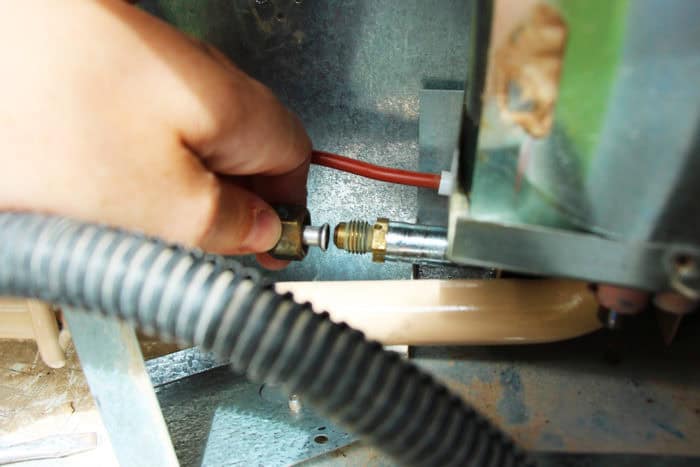
5. Remove The Burner Assembly
Once the propane line is removed you are ready to take out the burner assembly which includes the burner tube and the propane orifice.
You can do this by undoing the single screw securing the burner assembly to the flume.
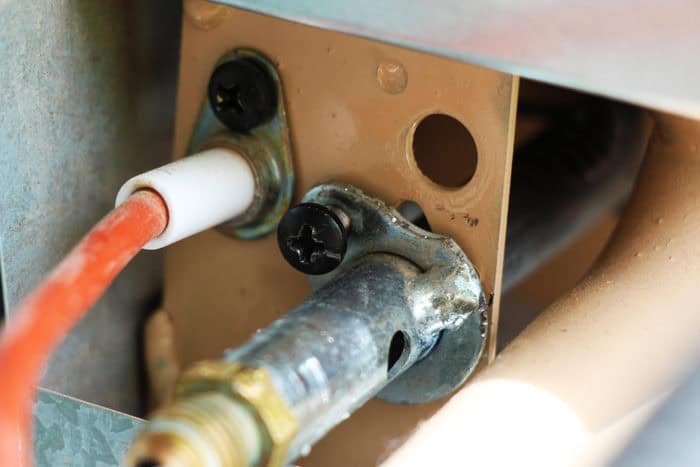
Once the screw has been removed carefully pull out the burner assembly.
It should look like the part in the picture below if you have a Norcold fridge, if you have a Dometic fridge it may look slightly different because sometimes Dometic uses a burner assembly where the orifice and the burner tube are one piece.
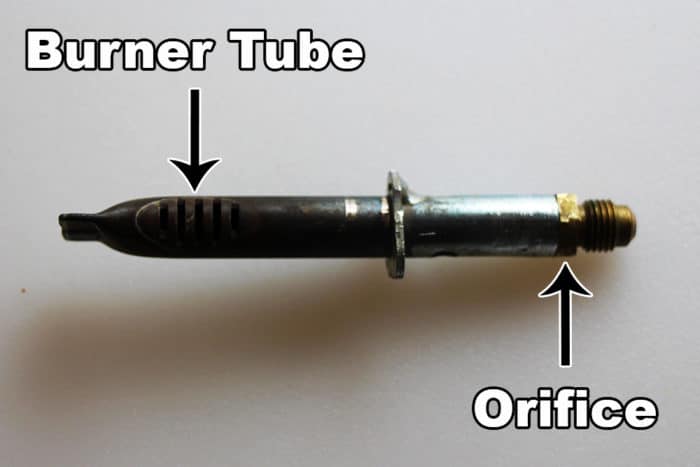
If you have a burner assembly like mine you can carefully undo the orifice from the burner tube and remove it.
It should be lefty loosey like normal.
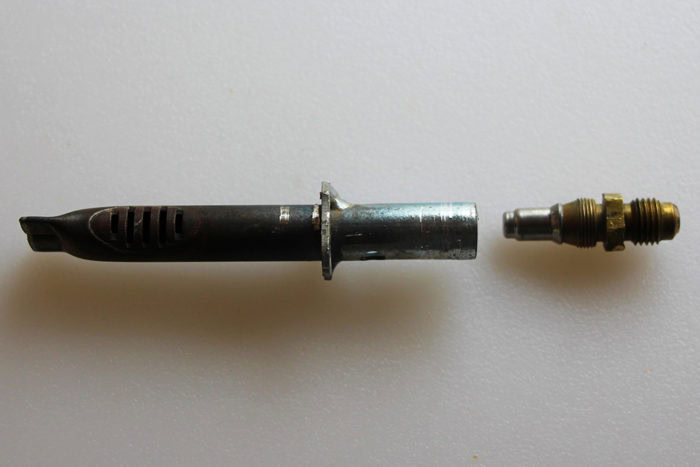
If you have a Dometic RV fridge you may be able to remove the small orifice by gently tapping it out. If you cannot remove it safely you may not be able to complete the soaking steps.
Try and clean it out as good as you can using a wire brush and compressed air just be careful not to damage the orifice or widen the hole as this could cause the flame to be too strong which may damage the RV fridge cooling unit.
You may be able to soak the orifice like in the step below by just putting the orifice end in alcohol.
See Also: How To Install Solar Panel On RV Roof & Connect To Battery
6. Soak The Orifice In Alcohol & Clean The Burner Tube
If you can remove the orifice now is the time to soak it in rubbing alcohol for around two hours.
You don’t want to stick anything into the small orifice hole because you may damage it.
The first time I cleaned the RV fridge orifice I was able to use isopropyl alcohol and it worked great.
The second time we were camping up in the mountains and unable to get any rubbing alcohol so I improvised and used vodka.
It’s not the recommended route but it actually worked pretty well and the orifice was clean after two hours of soaking.
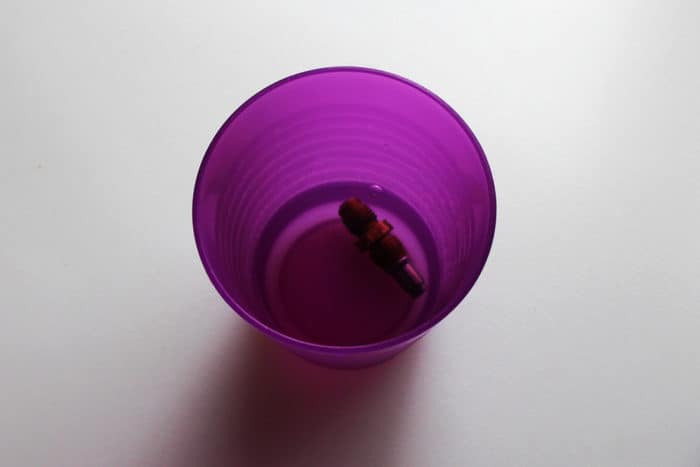
While the orifice is soaking you can clean the burner tube as well using a wire brush and compressed air.
If lots of soot comes out the burner tube may have also been part of the problem.
Spiders love to spin webs near propane parts like burner tubes and when you fire up the fridge the web can burn and cause lots of soot that can block the burner tube and make the flame small.
If you don’t have an air compressor handy compressed air cans like the ones used to clean computers (click to view on Amazon) work great.
7. Blow Out The Orifice
After a good soaking, the orifice is ready to be blown out and reinstalled.
Using compressed air from either a can or a compressor blow out the orifice from the end with the small hole.
You don’t want to use air that’s too strong when doing this as it could damage the orifice.
If you have a large air compressor try and only use a blower with low pressure.
You don’t want to blow from the large end because you don’t want more dirt and debris to get stuck in the tiny orifice.
Once you are done, inspect the orifice, it should be clean looking and a nice rectangle shape.
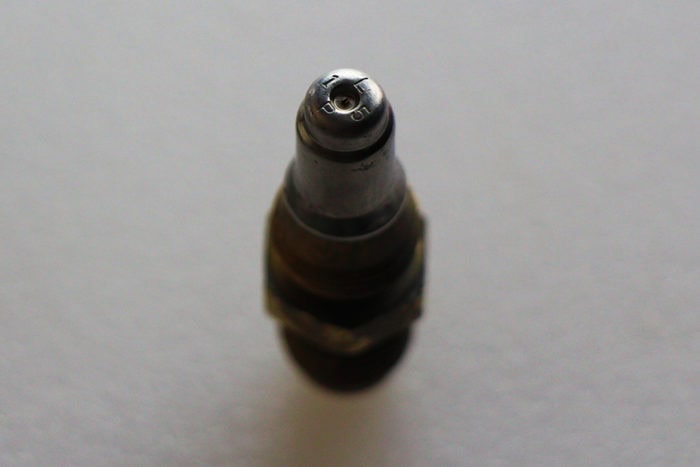
8. Reinstall The Burner Assembly
Once everything is clean carefully screw the orifice back into the burner tube. Make sure it’s secured tightly so there will be no leaks.
When everything is back in place you can now turn the propane back on.
Make sure you test the connection between the propane gas line and the orifice with soap water to make sure it’s tight and free of any leaks.
When the flame kicks on you should be able to hear it clearly even if the access door is closed.
The sound is even more important than how the flame looks.
RV Life Hack: How To Check How Much Propane You Have Left
If the orifice was the problem it should now be allowing more propane through and you should have a nice strong flame burning which will make the RV fridge get colder.
I hope this how-to post has helped you fix your RV fridge.
There are many other things that could be wrong but I have found that if you have an RV fridge that won’t cool enough the main problem is a dirty orifice.
It’s an easy trick you can try that only takes a few hours. If you’re lucky cleaning the orifice will get your fridge cooling properly again in no time.
Have any questions about your RV fridge or need help troubleshooting? Leave a comment below.


Well, I will tell you that this information makes far more sense then my fridge doesn’t get cold add a fan outside.
This as the least attempts to address the root cause of the issue. Yes adding fans will work providing you have a strong flame to begin with. Great article with easy to understand pictures. Well Done!
Thanks, Bob.
Yes, it’s worth trying. We would’ve saved a lot of money if we had just done this before buying a new cooling unit, but we didn’t know about it.
Jesse
After reading MANY articles to get my 2 year old camper fridge to run on propane again, this is the most straight forward, no bs article I have read. From my understanding, these units are not like a furnace where the pilot runs and then if the gas valve opens the burner lights. Instead, it is a variable burner (or pilot) if you will. If it lights, it is only how much gas goes through, and therefore how much heat that regulates the temp inside the refrigerator. If its plugged, it won’t get hot enough to cool down normally. Your article finally put the last pieces together for me. Thanks to you I finally pulled it apart. In a few hours we should know if this was the problem, but at $100/hr to troubleshoot an $800 refrigerator I am willing to try. I think it was the line where you used vodka (roughly 40% alcohol) to clean it in a pinch that related to me. It sounds like something I would try.
DP
Thanks for the feedback. It’s good to hear that this little trick might be helping others. I hope it was what your RV fridge needed, they can be tricky to diagnose sometimes.
My rv fridge only gets cold using lp gas. What could be the problem with the electric side?
It could be your electric heating element (click to view on Amazon) has gone bad. If you turn your fridge to electric and you don’t feel the fridge coils getting warm your heating element probably isn’t working. If you go to the link I gave that leads to Amazon you will see in the product pictures where the heating element is located. It’s pretty easy to change out yourself you just have to remove your fridge, then pull it out and replace it with a new one that is compatible with your model of RV fridge.
The heating element I linked to probably isn’t compatible with your RV fridge. I can help you find the right one if you tell me what the make and model of your fridge is though.
This is an interesting read! We have a Norcold unit as well. We take our motorhome to a local shop for its propane certification annually and they service the onboard tank and attachments, and connections to the appliances. It’s less than $200 and obviously well worth it! Suffice to say, we’ve not had a cooling issue that is propane (or electric) related. The one odd occasion when we had a cooling issue, it was related to the control board (?) rather than the heat source – we found an obscure reference online that it can get stuck on the warming cycle, did the recommended reset, and it worked. The flame is loud with our fridge. I had even asked the shop tech about it ie is it normal to have it so loud! Same goes with our water heater. We can always tell (from inside) when either appliance is lit.
What was the recommend reset. Abs where is it
Where is the recommended reset? We have a Norcold and electric and gas don’t work. Light is on for both. Will try cleaning orfice. How do we reset both like you mentioned?
Where is the recommended reset? We have a Norcold and electric and gas don’t work. Light is on for both. Will try cleaning orfice. How do we reset both like you mentioned? Where are your replies? cannot find them.
mine do not work with gas or electric so I will try both suggestion
Thanks a lot guys I a had this problem with my fridge and nobody could find it, but this solved the problem right away.
Awesome! Thanks for your comment, Frank.
Hi, I was adjusting the temp on Frig thermister finally got to 38 degrees the next day it was 50 than 60 then lost all power to frig got it to work on gas for about three hours then it quit?
Hi Anthony,
Sounds like you may have a thermostat problem. If the RV fridge was able to get down to 38° before it shouldn’t be an orifice or cooling unit issue.
If you lost all power to the fridge a fuse might have been blown. Check the fuse box first then I would replace the thermostat or try adjusting it again.
This was a great and straightforward article. LOVED the part about resorting to the Vodka cleanse. I too have done that and it worked well . . . for me, not tried it for the fridge though <;*)
I just went to follow your excellent suggestions. My 2008 Navion says to NOT remove the adaptor fitting from the orifice as it can damage the press-fit fitting and cause leakage later in the propane arena. Any thoughts for my “Now what . . . ?”
Hi Gwyny,
Thanks for the comments, I appreciate them. The vodka trick is still one of my better ideas.
If you can’t get the orifice off of the adapter you could either soak both of them or just stand the orifice side down in a cup of alcohol. It’s mostly about getting the tip of the orifice clean so it lets the proper amount of gas through.
Is it true that u should have very Little space between the Back of the fridge and the vent lid that fits on the trailer (back). This repair guy says the 8-9 inches our is is too much room and wants to build a panel to close it off & then put 4 fans in the space between The back of the fridge and the new panel.
Hi Marion,
It’s true that you want as little space as possible between the back of the RV fridge and the wall. Most manufacturers recommend less than 1 inch. This is so most of the airflow goes through the condenser fins to cool the fridge.
To solve this problem people add insulation on the back wall to help close the gap. Adding fans can also help quite a bit. We added two fans to the back of our fridge. 4 sounds like a little overkill but if you have an extra large RV fridge it might be necessary.
Bruce H
Pulled our hair out for weeks worrying about the low frig temps and the high weather temps. the orifice was cleaned—walla new frig many thanks for the help!!!!
Hey Bruce,
Thanks for the comment. I’m glad it helped!
Hiya! I have a 3-way Elixir Travlr from the 70s. Works great on electric but stopped cooling on propane a year ago. I followed a lot of advice on the web including cleaning the burner, tapping on and blowing out the flue, gently banging on the coils with a rubber mallet (for a couple of hours) – but I too had a nice blue flame coming from my burner. Sooooo, in yet what I figured was my real last ditch effort this time, I took it all apart and soaked the orifice in vodka. Thankfully, it was only McCormick’s. I then reassambled the orifice and blew it out with an airgun, put it back together and wow – my flame is at least 3 times the size it was previously. And definitely some warmth coming out of the vents. Pretty sure we’re gonna have ice here in a bit – thank you very much!
I have a Dometic On my 2011 rig we recently purchased. The fridge had a couple fuses blown and the owners didn’t know why the fridge wasn’t working. It was also tripping the GFI, after the fuses were replaced, which might be unrelated. Not sure.
I plugged it in to an extension cord that goes to my house. It’s been on hour or so (electric mode) not getting cold. There is a sound that sounds like a quiet engine revving. Steadily, over and over. This started pretty soon after I plugged it in, but not immediately. The chimney is hot. Any ideas?
Hi Anna,
It sounds like you may have a bad heating element in your fridge. It really shouldn’t be making a lot of noise when on electricity. The heating element is in the chimney so it makes sense that it’s getting hot but the fridge should also be getting cold.
Have you tried using it on propane? If it won’t get cold on propane either you may have both a bad heating element and possibly a blockage in the pipes that’s stopping the ammonia inside from moving around and transferring heat.
I would also take a look at the outlet the fridge is supposed to be plugged in to and make sure all of the wires are in place and nothing is damaged. The GFI outlet getting tripped could be related to the fridge outlet having issues.
We’ve bought our travel trailer new in 2014. I don’t think I had ever heard the refrigerator flame. On shore power it worked fine but always seemed to struggle on propane. This August while boondocking for several days, our suspicions were founded because it was not cooling. After watching many YOUTUBE videos I found this article and knew right away the burner was likely the problem because of it’s weak and quiet flame. Well after cleaning the assembly with alcohol as described, the flame is definitely much louder and the refrigerator is now working properly on propane! Thank you for a great article.
Thanks for the comment! I’m glad it worked for you too.
I Have a 2005 Forest River Sierra with a domestic fridge and it stopped cooling on both electric and gas when I put it on gas I can hear the gas going it’s just not cooling and electric the chimneys getting hot but not cooling any suggestions. I am a 65 year oldSenior with no man around that knows anything about this and I’m on Social Security so if it’s something I could try to fix myself I would be so grateful for any advice.
Hi Valerie,
Unfortunately, if your RV fridge isn’t cooling on gas or electricity you may have a bigger problem than just a dirty gas orifice.
My guess is that it’s either a clog in the heat coils or an ammonia leak. I wish I had a neat trick for that but it sounds like your heating element might need replacing which is a job that needs to be done by a professional.
Sorry, I wish I could be more helpful.
sometimes laying the unit down on its face for a while will allow the ammonia to flow out of the condenser coil caused by sitting for long periods.
Thanks for the tip, Jenni. It worked for me.
Hi Jenni,
Thank you! Just tested this out and worked like a charm. I used lacquer thinner instead of alcohol. 🙂
I’m glad it worked for you. Good idea on the lacquer thinner!
I did the orifice cleaning, the flame looks like you described it should. The freezer seems to be cooling but not the refrigerator. How long should I wait to know if cooling properly? Additionally, I decided to leave on overnight since it was 11 pm before reinstalling the orifice, in the morning I could smell propane so I just turned off propane bottle. Why would I smell propane, no leak at orifice.
Hi Tracy,
It shouldn’t take more than 24 hours for the fridge and freezer to get to the temperatures they need to be at.
The problem could be a clog in the coils that’s blocking the ammonia and not allowing the fridge part to cool. It’s a common problem and one that usually requires the cooling unit to be replaced.
As for the propane smell, that’s not normal. Make sure you check connections further down the gas pipe to make sure nothing was loosened when you removed the orifice.
sometimes removing the unit and laying it face down for an hour or so will allow the pooled up ammonia to flow out of the condenser , caused by lack of use .re-install an fire up.
Thanks Jenni
You pointed me in the right direction, I actually changed the burner rather than cleaning. Before I couldn’t hear the flame with my ear next to the unit, now I can stand 5 foot away and hear it roaring, and the fridge is now freezing.
You saved me the cost of a new fridge, thank you.
Kind regards
John
Hi John,
Thanks for letting us know that it worked!
FINALLY! So glad I found your post. Been having this exact issue with my fridge for a couple of years now. Did all the recommended things, cleaned coils, installed vent fan, replaced regulator, etc. but still didn’t work. Finally took it in for service and the tech changed the thermostat. That didn’t seem to help much either. It steadily got worse until it wouldn’t even get below 60 degrees. I had a nice blue flame (just like you noted in your post) so was left thinking the sodium chromate in the line had crystallized and plugged the entire works. After reading your post I disconnected the supply line at the burner tube and guess what…I found sediment scale blocking the jet/orifice. I disconnected the line from both the valve and burner side and cleaned it out with a pipe cleaner and compressed air, soaked the jet in alcohol for a couple of hours and put everything back together, fired it up and it started cooling almost immediately. Within an hour my fridge was down to temperature. Thank you so much for sharing your experience. I thought that just because I had a nice blue flame everything on the burner side was working properly. I know better now…it not only has to be a blue flame but it has to be the RIGHT flame which can only be delivered via a clean and unimpeded jet. Going forward I’ll likely add this to my yearly maintenance tasks and it will certainly be the first thing I check when troubleshooting problems with my fridge on gas. I’ve now added pipe cleaners, can of compressed air and alcohol to my onboard tool kit so I can fix this in the field too.
FINALLY!
So glad I found your post. Been having this exact issue with my fridge for a couple of years now. Did all the recommended things, cleaned coils, installed vent fan, replaced regulator, etc. but still didn’t work. Finally took it in for service and the tech changed the thermostat. That didn’t seem to help much either. It steadily got worse until it wouldn’t even get below 60 degrees. I had a nice blue flame (just like you noted in your post) so was left thinking the sodium chromate in the line had crystallized and plugged the entire works.
After reading your post I disconnected the supply line at the burner tube and guess what…I found sediment scale blocking the jet/orifice. I disconnected the line from both the valve and burner side and cleaned it out with a pipe cleaner and compressed air, soaked the jet in alcohol for a couple of hours and put everything back together, fired it up and it started cooling almost immediately. Within an hour my fridge was down to temperature.
Thank you so much for sharing your experience. I thought that just because I had a nice blue flame everything on the burner side was working properly. I know better now…it not only has to be a blue flame but it has to be the RIGHT flame which can only be delivered via a clean and unimpeded jet.
Going forward I’ll likely add this to my yearly maintenance tasks and it will certainly be the first thing I check when troubleshooting problems with my fridge on gas. I’ve now added pipe cleaners, can of compressed air and alcohol to my onboard tool kit so I can fix this in the field too.
Hi Steve,
It’s awesome to hear this worked for you! Adding it to your yearly maintenance sounds like a great idea.
Hopefully you’ll never have RV fridge cooling issues again.
Norcold fridge model #3163 is working fine but we smell strong odors coming from the outside vents. No smell inside trailer…just outside. What might this problem be ?? Does it have anything to do with thermocouple.
Thanks.
Hi Carl,
What kind of odors? Do you mean propane, ammonia, or a bad fridge/food smell?
My Norcold fridge runs on electricity and I can light it on propane but it will not stay running on propane. Help.
Hi Michael,
Is the flame weak and just dying on its own? Cleaning the orifice could still be the best option to try to make the flame stronger so it doesn’t go out.
Hi Jenni, thank you for a brilliantly presented article. I have a Dometic fridge/freezer, which is now running perfectly after following your article.
Chris (United Kingdom)
Thanks Chris, I’m happy to hear that it worked for you!
Excellent article, thanks! I cleaned my burn tube for a Dometic fridge. It now has a large flame. Maybe too large, after letting it run for a few hours, there is a burned wood smell and I can see burned wood under the burner. Could it be I damaged it and now there is too much flame? Or a blockage somewhere else?
Hi Jason,
If you used something other than rubbing alcohol to clean the orifice it might have been damaged. That’s why I don’t recommend using compressed air or any kind of wires or brushes to clean it out.
It could also be that it corroded and became damaged over time.
Burned wood is definitely a bad sign. At this point you should probably replace the burner with a new one to make sure it’s safe.
If your RV fridge is a Dometic, it should use this burner (click to view on Amazon). But check the compatible model numbers to be sure it’s the right one.
My thoughts: I’m thinking that if the flame is lit and boiling ammonia (in an RV fridge) and if the freezer is cold but the fridge isn’t, that either: 1) the flame is not high enough to boil enough ammonia to cool the fridge after it has cooled the freezer or 2) that there is an airflow blockage that is preventing the ammonia passing by the fridge from condensing and cooling the fridge. These are gravity driven systems and once ammonia begins to boil, the system is on auto pilot and cools as long as it has a large enough flame and sufficient airflow. I would think that the most a bad thermistor or control board could do would be to kill the flame but if there’s already a flame and yet insufficient cooling I suspect the flame is too small or that there’s an airflow blockage. Thoughts?